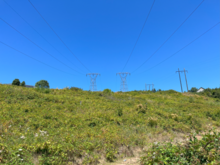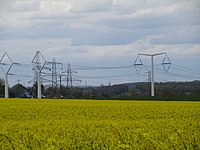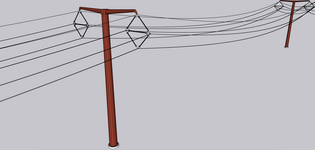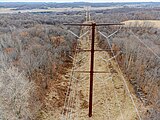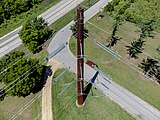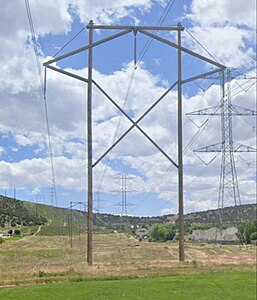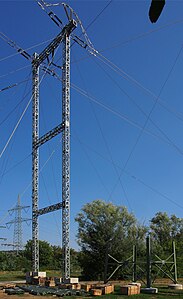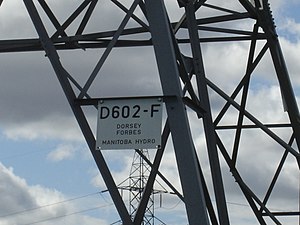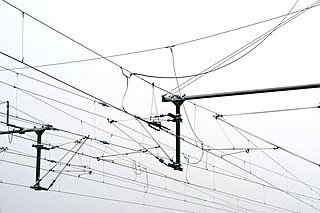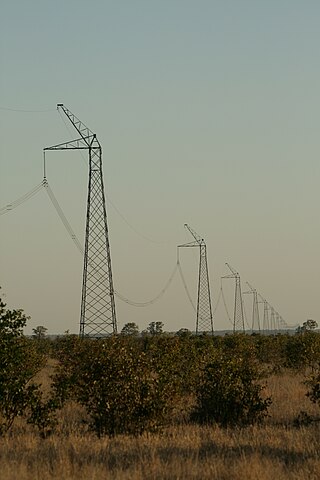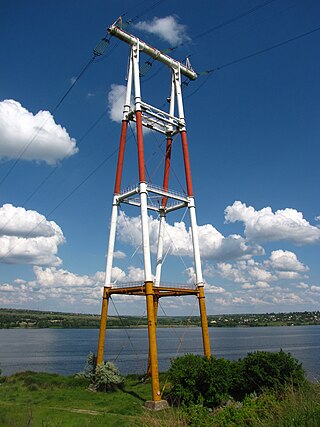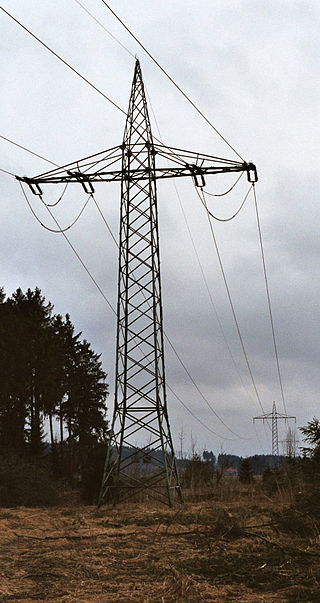| Tower | Year | Country | Town | Pinnacle | Remarks |
|---|
| Jintang-Cezi Overhead Powerline Link | 2018-2019 | China | Jintang Island | 380 m | 2656 metres long span between Jintang and Cezi island |
| Zhoushan Island Overhead Powerline Tie | 2009–2010 | China | Damao Island | 370 m | [27] built by State Grid [28] |
| Jiangyin Yangtze River Crossing | 2003 | China | Jiangyin | 346.5 m | |
| Amazonas Crossing of Tucuruí transmission line | 2013 | Brazil | near Almeirim | 295 m [29] | Tallest electricity pylons in South America |
| Yangtze River power line crossing of Shanghai-Huainan Powerline | 2013 | China | Gaogouzhen | 269.75 m | |
| Nanjing Yangtze River Crossing | 1992 | China | Nanjing | 257 m | Tallest reinforced concrete pylons in the world |
| Pylons of Pearl River Crossing | 1987 | China | Pearl River | 253 m + 240 m | |
| Orinoco River Crossing | 1990 | Venezuela | Caroní | 240 m | |
| Hooghly River Crossing | | India | Diamond Harbour | 236 m | |
| Pylons of Messina | 1957 | Italy | Messina | 232 m (224 m without basement) | Not used as pylons any more |
| HVDC Yangtze River Crossing Wuhu | 2003 | China | Wuhu | 229 m | Tallest electricity pylons used for HVDC |
| Elbe Crossing 2 | 1976–1978 | Germany | Stade | 227 m | Tallest electricity pylons still in use in Europe |
| Chushi Powerline Crossing | 1962 | Japan | Takehara | 226 m | Tallest electricity pylons in Japan |
| Daqi-Channel-Crossing | 1997 | Japan | Takehara | 223 m | |
| Overhead line crossing Suez Canal | 1998 | Egypt | | 221 m |
| Huainan Luohe Powerline Crossing | 1989 | China | Huainan | 202.5 m | Pylons of reinforced concrete |
| Yangzi River Crossing of HVDC Xianjiaba – Shanghai | 2009 | China | ??? | 202 m [30] | |
| Balakovo 500 kV Wolga Crossing, Tower East | 1983–1984 | Russia | Balakovo | 197 m | Tallest electricity pylon in Russia and ex-USSR |
| LingBei-Channel-Crossing | 1993 | Japan | Reihoku | 195 m | |
| Doel Schelde Powerline Crossing 2 | 2019 | Belgium | Antwerp | 192 m | Second crossing of Schelde River |
| 400 kV Thames Crossing | 1965 | UK | West Thurrock | 190 m | |
| Elbe Crossing 1 | 1958–1962 | Germany | Stade | 189 m | |
| Antwerp Deurganck dok crossing | 2000 | Belgium | Antwerp | 178 m | Crossing of a container quay |
| Tracy Saint Lawrence River Powerline Crossing | ? | Canada | Tracy | 176 m | Tallest electricity pylon in Canada |
| Línea de Transmisión Carapongo – Carabayllo | 2011 | Peru | Lima | 170.5 m | Crossing of Rimac River in a 1055 metres long span |
| Doel Schelde Powerline Crossing 1 [31] | 1974 | Belgium | Antwerp | 170 m | Group of 2 towers with 1 pylon situated in the middle of Schelde River |
| Sunshine Mississippi Powerline Crossing | 1967 | United States | St. Gabriel, Louisiana | 164.6 m | Tallest electricity pylons in the United States , |
| Lekkerkerk Crossing 1 | 1970 | Netherlands | Lekkerkerk | 163 m | Tallest crossing in the Netherlands |
| Bosporus overhead line crossing III | 1999 | Turkey | Istanbul | 160 m | |
| Balakovo 500 kV Wolga Crossing, Tower West | 1983–1984 | Russia | Balakovo | 159 m | |
| Pylons of Cadiz | 1957–1960 | Spain | Cadiz | 158 m | |
| Maracaibo Bay Powerline Crossing | ? | Venezuela | Maracaibo | 150 m | Towers on caissons |
| Meredosia-Ipava Illinois River Crossing | 2017 | United States | Beardstown | 149.35 m | |
| Aust Severn Powerline Crossing | 1959 | UK | Aust | 148.75 m | |
| 132 kV Thames Crossing | 1932 | UK | West Thurrock | 148.4 m | Demolished in 1987 |
| Karmsundet Powerline Crossing | ? | Norway | Karmsundet | 143.5 m | |
| Limfjorden Overhead powerline crossing 2 | ? | Denmark | Raerup | 141.7 m | |
| Saint Lawrence River HVDC Quebec-New England Overhead Powerline Crossing | 1989 | Canada | Deschambault-Grondines | 140 m | Dismantled in 1992 |
| Pylons of Voerde | 1926 | Germany | Voerde | 138 m | |
| Köhlbrand Powerline Crossing | ? | Germany | Hamburg | 138 m | |
| Bremen-Farge Weser Powerline Crossing | ? | Germany | Bremen | 135 m | |
| Pylons of Ghesm Crossing | 1984 | Iran | Strait of Ghesm | 130 m | One pylon standing on a caisson in the sea |
| Shukhov tower on the Oka River | 1929 | Russia | Dzerzhinsk | 128 m | Hyperboloid structure, 2 towers, one of them demolished |
| Tarchomin pylon of Tarchomin-Łomianki Vistula Powerline Crossing | ? | Poland | Tarchomin | 127 m | |
| Skolwin pylon of Skolwin-Inoujscie Odra Powerline Crossing | ? | Poland | Skolwin | 126 m | |
| Enerhodar Dnipro Powerline Crossing 2 | 1977 | Ukraine | Enerhodar | 126 m | |
| Inoujscie pylon of Skolwin-Inoujscie Odra Powerline Crossing | ? | Poland | Inoujscie | 125 m | |
| Bosporus overhead line crossing II | 1983 | Turkey | Istanbul | 124 m | |
| Tista River Crossing | 1985 | India | Jalpaiguri | 120 m | Pile Foundation |
| Duisburg-Wanheim Powerline Rhine Crossing | ? | Germany | Duisburg | 122 m | |
| Łomianki pylon of Tarchomin-Łomianki Vistula Powerline Crossing | ? | Poland | Łomianki | 121 m | |
| Little Belt Overhead powerline crossing 2 | ? | Denmark | Middelfart | 125.3 m / 119.2 m |
| Little Belt Overhead powerline crossing 2 | ? | Denmark | Middelfart | 119.5 m / 113.1 m |
| Pylons of Duisburg-Rheinhausen | 1926 | Germany | Duisburg-Rheinhausen | 118.8 m | |
| Bullenhausen Elbe Powerline Crossing | ? | Germany | Bullenhausen | 117 m | |
| Lubaniew-Bobrowniki Vistula Powerline Crossing | ? | Poland | Lubaniew/Bobrowniki | 117 m | |
| Świerże Górne-Rybaków Vistula Powerline Crossing | ? | Poland | Świerże Górne/Rybaków | 116 m | |
| Ostrówek-Tursko Vistula Powerline Crossing | ? | Poland | Ostrówek/Tursko | 115 m | |
| Bosporus overhead line crossing I | 1957 | Turkey | Istanbul | 113 m | |
| Riga Hydroelectric Power Plant Crossing Pylon | 1974 | Latvia | Salaspils | 112 m | |
| Bremen-Industriehafen Weser Powerline Crossing | ? | Germany | Bremen | 111 m | Two parallel running powerlines, one used for a single phase AC powerline of Deutsche Bahn AG |
| Probostwo Dolne pylon of Nowy Bógpomóz-Probostwo Dolne Vistula Powerline Crossing | ? | Poland | Nowy Bógpomóz/Probostwo Dolne | 111 m | |
| Ameren UE Tower | 2009 | United States | St. Louis, Missouri | 111 m | Radio tower with crossbars for powerline conductors |
| Daugava Powerline Crossing | 1975 | Latvia | Riga | 110 m | |
| 380 kV Ems Overhead Powerline Crossing | ? | Germany | Mark (south of Weener) | 110 m | |
| Nowy Bógpomóz pylon of Nowy Bógpomóz-Probostwo Dolne Vistula Powerline Crossing | ? | Poland | Nowy Bógpomóz | 109 m | |
| Regów Golab Vistula Powerline Crossing | ? | Poland | Regów/Golab | 108 m | |
| Orsoy Rhine Crossing | ? | Germany | Orsoy | 105 m | |
| Kerinchi Pylon | 1999 | Malaysia | Kerinchi | 103 m | Tallest strainer pylon in the world, not part of a powerline crossing of a waterway |
| Limfjorden Overhead powerline crossing 1 | ? | Denmark | Raerup | 101.2 m | |
| Enerhodar Dnipro Powerline Crossing 2 | 1977 | Ukraine | Enerhodar | 100 m | Pylons standing on caissons |
| Reisholz Rhine Powerline Crossing | 1917 | Germany | Düsseldorf | ? | Under the legs of the pylon on the east shore of Rhine there runs the rail to nearby Holthausen substation |
| Sone River Crossing | 1983 | India | Sone Bhadra (Uttar Pradesh) | 96 m | Pylons standing on Well Foundation |
| Ghazi pond crossing Tarbela Dam | 2017 | Pakistan | Tarbela Dam | 89.5m | SPT type tower. First of its type in Pakistan |
| Al Batinah expressway Road & Rail crossing at Sohar 220 kV Double circuit OETC line | 2018 | Oman | Sohar | 89 m | Tallest Transmission line tower in Sultanate of Oman |
| Strelasund Powerline Crossing | ? | Germany | Sundhagen | 85 m | Pylons standing on caissons |
| Pylon in the artificial lake of Santa Maria | 1959 | Switzerland | Lake of Santa Maria | 75 m | Pylon in an artificial lake |
| Facility 4101, Tower 93 | 1975 | Germany | Hürth | 74.84 m | carried until 2010 an observation deck |
| Zaporizhzhia Pylon Triple | ? | Ukraine | Zaporizhzhia | 74.5 m | Two triple pylons used for a powerline crossing from Khortytsia Island to the east shore of Dneipr |
| Aggersund Crossing of Cross-Skagerrak | 1977 | Denmark | Aggersund | 70 m | Tallest pylons used for HVDC-transmission in Europe |
| Eyachtal Span | 1992 | Germany | Höfen | 70 m | Longest span of Germany (1444 metres) |
| Leaning pylon of Mingjian | ? | Taiwan | Mingjian | ? | Earthquake memorial |
| Carquinez Strait Powerline Crossing | 1901 | United States | Benicia | 68 m + 20 m | World's first powerline crossing of a larger waterway |
| Tower 1 of Powerline Reuter-West - Reuter | 1987 | Germany | Berlin | 61.3 m | Chimney-like strainer however not useable as smokestack, design was chosen in order to fit better into the surrounding industrial area |
| Pylon 310 of powerline Innertkirchen-Littau-Mettlen | 1990 | Switzerland | Littau | 59.5 m | Tallest pylon of prefabricated concrete |
| Huddersfield Narrow Canal Pylon | 1967 | UK | Stalybridge, Greater Manchester | 54.6 m | Pylon standing over a waterway shipable by small boats |
| Anlage 2610, Mast 69 | ? | Germany | Bochum | 47 m | Pylon of 220 kV powerline decorated with balls in Ruhr-Park mall. |
| Colossus of Eislingen | 1980 | Germany | Eislingen/Fils | 47 m | Pylon standing over a small river |
| Pylon 24 of powerline Watari-Kashiwabara | ? | Japan | Uchihara, Ibaraki | 45 m | Pylon standing over a public road with two lanes |
| Designer high-voltage pylon Bog Fox | 2020 | Estonia | Risti, Lääne County | 45 m | The first high-voltage designer pylon in Estonia |
| Sookurg | 2022 | Estonia | Tartu-Tiksoja, Tähtvere County | 44 m | designer pylon |
| Sookureke | 2023 | Estonia | Jõhvi–Tartu–Valga, Mustvee County | 40 m | designer pylon |
| Mickey Pylon | 1996 | US | Celebration, Florida | 32 m | Mickey mouse shaped pylon |
| Source [32] | 2004 | France | Amnéville les Thermes | 34 m / 28 m | 4 pylons forming an artwork |
| Western Tower of Overhead Line of Ostrich Lake Ferry | 1915 | Germany | Strausberg | 9.7 m | carries together with its counterpart on the other bank of Ostrich Lake the longest span (length: 370 metres) of an overhead wire for feeding electric power to a vehicle |
| Eastern Tower of Overhead Line of Ostrich Lake Ferry | 2006 | Germany | Strausberg | 9.6 m | carries together with its counterpart on the other bank of Ostrich Lake the longest span (length: 370 metres) of an overhead wire for feeding electric power to a vehicle |



